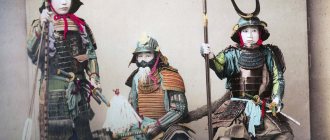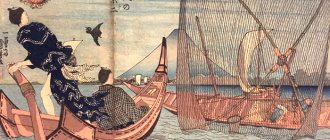Veneration of the fan in Japan
In Japan, the fan remained an equally favorite accessory for women and men. The warriors could not part with it even during the war, so the elegant object underwent many transformations. The fan turns from a harmless colorful trinket into a formidable weapon, striking the enemy like a samurai sword.
Over time, fans acquire specific functions depending on their purpose. Therefore, combat, signal and combined structures arose that could not only be used to fight, but also to fan oneself. And for a person in military uniform, the presence of a fan became not a whim, but a necessity, especially during long campaigns under the hot sun.
The fan was in the possession of the commanders of the detachments, and the drawing on this object was used to judge whether the unit belonged to a certain clan. During the battle, the fan gave signals, thanks to which it was possible to control the actions of the soldiers without words. And for the Japanese aristocracy, an expensive accessory was evidence of the rank of the owner; it displayed certain patterns and colors.
Fan: beautiful and deadly
In China, the fan was not used quite traditionally. It was used in the philosophical, martial and alchemical teachings of Taijiquan, Tao and others.
Many similarities were found between fans and butterflies, and the belief arose that exercises with a fan make the one who practices them similar to a butterfly. The main feature of working with a fan is the development of the ability to combine the force of the fan with the force of the body.
It was in Japan that the familiar image of a fan developed . With the idea of making everything more perfect, Japanese masters changed shapes and as a result created a folding fan from wooden planks , which were folded into an accordion in a semicircle, it is called sensu. The rest of the fans were made on its basis.
Beautifully painted fans were a set for the ceremonial women's kimono "Tomesode".
In 988, the Emperor of China was presented with an improved version of the fan. Even two bat fans and 20 other colorful folding fans. In China, they fell in love with the shape of the Japanese fan, which they began to paint with traditional Chinese landscapes.
In Japan, the image of the fan continued to be improved. It acquired particular significance in the Heian and Nara eras.
There was also a custom of making large paired matrimonial fans, which were used to decorate the house or to be taken to guests as an integral item of etiquette. A custom arose of seasonally painting fans with flowers that were supposed to match the hairstyle, kimono, and home interior, creating a relaxed and unique charm.
There were also fighting fans. They were made of iron, they were folding or always open. When folded, the fan was used as a club; when unfolded, it was used to protect against throwing weapons.
Types of dangerous accessories
- Gunsen is a folding fan. It was used for its intended purpose, to fan oneself in the heat. The inner spokes were made of bronze, wood, brass or other metal. The covering and outer spokes were made of iron. This design was lightweight, but also extremely strong. Warriors preferred to hide the gunsen fan in the belt or chest area, but with the second option you cannot use a bow or sword.
- Tessen is a folding type of fan whose outer spokes are made of iron plates. In appearance it resembles an ordinary fan, but when folded it is used instead of a baton. Samurai could enter with such weapons at the ready where it was forbidden to wield a sword. In fencing schools they taught how to fight using the tessen. A tessen battle fan was used to deflect flying darts and arrows, throw it towards the enemy, or use it when crossing a river.
- Gunbai, gunpai or dansen uchiwa is a solid open fan of significant dimensions, made entirely of iron or wood with the inclusion of metal components. Famous military leaders walked around with such a fan; they used it to repel darts and arrows, and also signaled the method of fighting to their troops.
Uma-sirusi - a descendant of the battle fan
The descendants of these fans were simply huge fans made of silk, attached to one and a half meter poles and called uma-sirusi . These fans were used as a military emblem and a sign of the shogun's presence during the Tokugawa reign.
Uma-sirusi were made from nine layers of paper glued together, and the top was covered with silk and gilding. Fans were also decorated with huge bunches of palm fibers or horsehair and attached to a pole in such a way that they could rotate when the wind blew. It should also be noted that fans made from animal materials - leather or bird feathers - were never widespread in Japan. This is due to the taboo on the "dead" established by the indigenous religion of the Japanese, as well as the subsequent precepts of Buddhism against killing in any form. That is why the insignia of Chinese military leaders, reminiscent of a fly swatter, when it came to Japan, began to be made from paper strips attached to a short handle. This design was called saihai and was a kind of pointer or conductor's baton when giving orders.
Fans for personal use have an equally ancient history, the beginning of which is shrouded in fog, and are divided into two groups:
1) a hard, usually rounded fan with an oblong handle (uchiwa, or dansen);
2) a folding fan, shaped like a sector of a disk (ogi, or sensu).
Uchiwa are mentioned in the most ancient chronicles of the Japanese and their origin can be deduced from the court custom of carrying a small flat stick (saku) made of wood or ivory, which was pressed against the lower part of the chest at a slight angle, thus supporting posture and giving it grandeur. As can be seen from history, uchiva successfully replaced saku.
Converting a fan into a weapon
Wooden fans were very fragile and often broke, so they began to make them from metal knitting needles. Such “iron fans” began to be called “tessen”. There is no documented evidence of who first came up with the idea of using tessen as a weapon.
Japanese martial art using such an accessory is called “tessen-jutsu”. The technique of fighting and wielding a fan in tessen-jutsu is reminiscent of kendo, that is, the tactics of sword fighting. But the specifics of using a fan are distinguished by many special techniques unique to this type of martial arts.
The iron fan, when folded, is used for attack, and when unfolded, it is used as defense. According to an ancient legend, such a weapon was created by the warrior Minamoto no Yotshinsune, who defeated the mythical monster tengu in battle by holding the tip of his spear between the plates of a fan.
Since then, many martial arts schools have mandatory taught fighters the skill of tessen-jutsu. This martial art received special development in the famous Shinkage-ryu school. In some provinces, there are still masters who wield fans, by analogy with the ancient Japanese martial arts such as sumo, aikido, kyu-do, yabusame (shooting while riding a horse at a running dog using a Japanese bow).
Login to the site
Give me a Japanese fan and the moon in a glass of wine. I want to turn into the wind. Change names on the fly. The soul is full of the dark sky, And is about to fly away to the north From the open window - If only there were a Japanese fan. Eva Tenetskaya
In Japan, fans were used by representatives of a wide variety of social classes and for a variety of purposes: in theatrical performances and dances, poetry and social life, as well as when winnowing rice or wheat. The fan was also used as a deadly military weapon, and such use of the fan first appeared in Japan, and in no other country in the world.
Fans for personal use have an ancient history, the beginning of which is shrouded in fog, and are divided into two groups:
- a hard, usually rounded fan with an oblong handle (uchiwa, or dansen); - a folding fan, shaped like a sector of a disk (ogi, or sensu). Uchiwa are mentioned in the most ancient chronicles of the Japanese and their origin can be deduced from the court custom of carrying a small flat stick (saku) made of wood or ivory, which was rested on the lower part of the chest at a slight angle, thus supporting posture and giving it grandeur. As can be seen from history, uchiva successfully replaced saku.
Many scientists consider the folding fan to be a truly Japanese invention, despite the ambiguity and inaccuracy of information about its origin. This is due to the fact that in the chronicles of the Chinese Song dynasty already mentioned above there is information about “Japanese fans”, and we are talking about this type of fan, the ogi. This may serve as proof that the ancient Chinese had nothing to do with folding fans, despite the fact that the later Confucians, admiring Chinese culture, attributed the ogi to Chinese origin.
Folding fans became especially popular at court and served as personal insignia, communicating the rank and position of their owner. Ogi were also used in court ceremonies. Subsequently, this type of fan was improved to suit the needs of the military class that came to power, in particular, the wooden knitting needles were replaced with iron ones, and the ribs of the fan were strengthened with varnish. Also, by this time, bushi (warriors) already knew and used battle fans, which apparently had the same rounded shape and were extremely rigid. Such fans are known as gumbai.
Initially, gumbai was carried by all detachment commanders, but with the beginning of the Tokugawa period, it became the special prerogative of the commanders-in-chief, and such battle fans became very sophisticated and were decorated with multi-colored cords, indicating the rank or clan affiliation of the owner. The designs for such fans included the constellation Ursa Major, dragons, yin and yang symbols, hurricanes and others, but in the end the dominant motif became the emblem of a clan or family.
Military fan - gumbai-utiwa. End of the 18th century
With the help of gumbai (i.e. a certain kind of gesture using a fan), military leaders gave orders, fans were also used to challenge a fight, and nowadays gumbai can be found in the hands of a judge in sumotori fights.
However, from the point of view of lethality, fans such as gunsen and tetsusen (tessen) are of much greater interest. Gunsen were worn with bushi in armor, while tessen were worn with casual clothing. Both of these fans were useful weapons for both attack and defense and usually had eight or ten spokes. Many ryu around the country taught the technique of fighting with such a fan - tessenjutsu, the techniques of which, as a rule, mostly repeated the sword training program.
As might be expected, many legends surround the origin of the iron fan method of fighting. One of them, for example, tells how Yoshitsune, the hero of many Japanese legends, defeated the giant Benkei (who later became his devoted follower), repelling the blows of his opponent’s spear with his iron fan, and then, holding the shaft between the hard ribs of the fan, which tore the spear from Benkei’s hands . The secrets of fighting with a fan, according to legend, were revealed to him by the forest deity tengu, who had previously taught him the art of wielding
sword
.
In the literature on martial arts, cases of victories won with the help of only one fan are often described. Very often, experienced fencers, confident in their abilities, used a battle fan without bothering with sword fencing. The legendary swordsman of the 16th century Ganryu, according to legend, emerged victorious and without a single scratch from a battle with several opponents and used a battle fan.
The ability to use such a fan as a weapon also gained popularity among representatives of other social classes who were forbidden to carry a sword due to their “low origins.” The Tessen could be used for fencing, fending off flying darts and knives, or coordinating the actions of subordinates, as well as using the fan in any other way. The tessen battle fan had an innumerable number of purposes directly related to the professional duty of a samurai - conducting combat operations. A warrior could fence with it, snatching the sword from the enemy’s hands, pinching the blade between the steel ribs of the fan and sharply pulling it towards himself. Could reflect knives and poisoned darts thrown at him. Moreover, the fan served as an important part of the training of certain swimming techniques taught in many martial arts schools.
Japanese samurai battle fan TESSEN is a black folding command fan in the form of a gunsen-gata with 10 metal plates and with the image of the samurai family coat of arms (mona) of the Ichizen clan on both sides of the fan. On one of the metal plates is the master’s signature. Rarity! Has museum value.
Multilayer Japanese paper (washi), varnish, engraving, gilding. Edo era, late 18th century.
On the top metal plate there are 5 hieroglyphs, Hi Ri Ho Ken Ten, which are an acronym for a modified poetic saying of the outstanding commander Kusunoki Masashige, who went down in history as a symbol of military talent and samurai spirit. Meaning of hieroglyphs: Hi-cruelty, Ri-principle, Ho-law, Ken-sword, Ten-heaven. The approximate meaning of the acronym: Cruelty has no power over principles. Principles have no power over the law. The law has no power over the sword. The sword has no power over the heavens.
Without a doubt, the art of using a battle fan is the most unusual and rarest type of kobudo technique. It’s hard to think of a more peaceful object than a fan, and yet it can also be a weapon. There is no mysticism in this and there is no secret technique either. It’s just that a not quite ordinary fan is used in the duel. And to be completely precise, it is completely unusual. The fan's lethality lay in the fact that it was equipped with sharp blades, which were placed in the folds and at the ends of the fan, giving it even more cutting and impact properties. The speed and effectiveness of using the fan was so unexpected that the dying victim could not understand what
happened to her.
The striking surface of the fan was its side parts, the tip of the handle and the tops of the ribs of the fan when open. From the moment when the ribs of the fan began to be made of hard wood, a blow to the temple or throat of an opponent could easily cause death. Today, fanning techniques do not include elements that can cause loss of consciousness, pain or temporary paralysis.
The side surfaces of the fan were used to block punches and kicks. The contact targets for the fan were acupuncture points taken from Eastern medicine, which caused a wide range of injuries: from severe pain to loss of consciousness, paralysis or death.
The most commonly used points for fan strikes are above and below the knee. When sharply poked here, the enemy falls or loses balance. Sensitive points near the wrist are also used, where a blow can allow you to knock out an object or weaken its grip. Hitting points on the instep or the back of the calf muscle can cause the opponent to lose balance. The force of manipulating the fan is created by the speed of the swing through the action of a relaxed hand. The sweeping motion of the hand creates both the speed and impact capabilities of the fan. Modern masters show how they throw their opponents to the ground with the movement of a fan, without damaging a single feather of the fragile frame of the fan. And one can only imagine what a person feels when he was hit by an innocent-looking fan.
Today, the art of the martial fan is still practiced by a few specialists in Japan, so that the ancient, heavy gumbai, along with other specialized weapons of the feudal era, appears from time to time in the training techniques of modern coordination disciplines such as karate, aikido and kendo.
vsiaco.org.ua
Popularity of tessen-jutsu
Tessen-jutsu became widespread among the lower strata of society, who did not have the right to use a sword. Experienced fighters reached such a height of mastery of their weapons that they could cope with several opponents armed with samurai swords.
One ancient chronicle tells about an incident in the life of a martial arts master named Gann-ryu, who, thanks to his skillful use of a battle fan, was able to emerge victorious from a confrontation with 10 opponents. At the same time, not a single scratch remained on it.
History of the battle fan
In Japan, two types of fans developed and modified. One of them, familiar to everyone, was made of plates and covered with thick paper. If it is expanded, the structure takes the shape of a semicircle. In its homeland it is called “ogi” or “sensu” (sen). In this form it becomes known in Europe, where it became known as the Japanese fan, although in its homeland it is considered a peasant fan and is used for sifting rice from the husk.
The second variety has its own specifics and is called “dansen” or “uchiva”. This is a round fan with a rigid handle. In ancient pictures you can often see such a Japanese fan; most often it is depicted in the hands of the nobility. The origin is due to the modernization of a wide stick for correct posture - saku, which was used to hold the chin and chest during ceremonies. Later the stick turned into a fan and began to symbolize the status of the owner.
Japanese battle fan. How did a fanning leaf become a personal weapon?
In Japan, the fan has existed since time immemorial; all classes use it. Peasants use it to winnow rice, aristocrats and geishas use it as part of their costume, artists for theatrical performances... The bushi (military class) also did not stand aside. In war, all means are good if they help fight effectively.
Historically, two types of fans developed in parallel in Japan.
The first is the one that is well known to us: folding, folded from flat plates or made of thick paper. When unfolded, it looks like a semicircle or sector of a disk. In Japan, such a fan is called ogi or sensu (abbreviated as sen). Such a fan came to Europe from China, where it was called the “Japanese fan.” Historically in Japan it was considered “peasant”; it was with this fan that Japanese peasants winnowed rice, separating it from the husk.
The second type of fan is a non-folding round fan with a rigid handle. This design is called uchiwa or dansen. This fan is mentioned in the most ancient Japanese chronicles as part of the costume of the Japanese aristocracy. It happened through a kind of “modernization” of a wide flat stick to maintain the posture of the saku, which was pressed against the chest and chin during long ceremonies. And then they made this stick into a means of fanning and... a “status symbol.” Well, like a modern huge smartphone for 5,000 euros. Gradually, this fan remained only a status symbol, and more practical folding fans began to be used for fanning.
Let's return to the topic of the article. Military.
“The first ideal of a warrior is the unity of man and his sword. When he achieves this, even a blade of grass can become a weapon in his hands.” Phrase from the movie "Hero".
What associations does the word “military” evoke? Especially in the Middle Ages? Hand-to-hand combat, a commander on horseback, a colorful procession... The Japanese used the fan wherever possible.
For example, in ceremonies and parades. Large silk fans of uma-shi-rushi (translated as “horse pennant”) were used as banners or attributes of military processions.
The tough uchiwa was more of a status symbol than a weapon. For generals and commanders, a very long time ago they began to make strong fans with an iron handle to repel the blow of a sword. He was called "gumbai" or "gumbai-utiwa". A bright design was applied to such a fan, visible from afar, and it was used as a command staff and a means of self-defense in the most extreme cases. Such a fan was a constant attribute of Japanese military leaders until the middle of the 19th century.
But every samurai had a combat ogi. It was made in a variety of modifications and was called tessen (tessen) or gunsen (translated as “iron fan”). It was made either entirely from thin iron strips, or there were iron strips only along the edges of the fan. The mass of the fan is from 200 to 500 grams. Made from eight to ten strong plates, most often iron. Covered with waterproof varnish. The warrior's tessen with the image of the samurai family coat of arms (mona) helped identify the fallen. Sometimes short sharp blades were placed at the end of the plates. The outer stripes, both or just one, were also sharpened sharply. The first mentions of the use of such battle fans are found in chronicles starting from the end of the 12th century.
The art of using a battle fan is called tessenjutsu and includes elements of defense and attack with the help of such an unusual “weapon”. According to legend, it was created at the end of the 12th century by the Japanese warrior Minamoto no Yoshitsune. It is believed that Yoshitsune defeated the mythical creature tengu (super-mega martial artist) by clamping the fan's plates on the tip of his spear. After this, the tengu gave in and taught Yoshitsune everything he knew.
Since then, the study of tessenjutsu has become mandatory in many schools of martial arts. The work technique is divided into two large parts: with a folded fan and an unfolded one. When folded, the fan was used mainly as a club. Pokes, blows, protection from various types of weapons. An unfolded fan was primarily used as a shield to protect against arrows, shuriken (sharpened metal plates) and other thrown weapons. Opening and closing the fan during the fight additionally distracted the enemy's attention. At a very close distance, a suddenly opened fan blocked the enemy’s view.
Many interesting stories are associated with tessen, which are recorded in Japanese chronicles.
Thus, the famous swordsman Gunn-ryu (late 16th century) fought off ten suddenly attacking opponents with just an iron fan and emerged from the skirmish without a single scratch.
The famous swordsman, master and teacher of martial arts, Matsumura Sokon was summoned to the palace of the shogun (regional ruler, governor) and had to fight with only one fan with an angry bull. Matsumura asked for ten days to train. During this time, having bribed the guards, the cunning samurai beat the bull every day from behind the fence on the nose with his tessen until the animal fell to its knees. Only then did he stop this torture. During the battle, Matsumura, when an angry bull was rushing at him, simply opened his fan. The animal stopped and fell to its knees. The shogun and his guests were delighted, and the samurai received a well-deserved reward.
There is also a known case when an iron fan saved the life of its owner in a very interesting way. The emperor planned to kill the offending military leader, but so that this story would not cause any misunderstandings. According to etiquette, a warrior had to kneel down, place a tessen in front of him and bow to the ground when entering the imperial chambers. Here the servant had to sharply move the heavy door and break the offender’s neck. However, before bowing, the warrior placed his tessen precisely in the groove of the sliding door. Naturally, the murder did not work out, the warrior rose from his knees and, as if nothing had happened, went to the emperor’s chambers, where he was generously forgiven. This is how it happens...
But everything passes. The era of the battle fan has also passed. When the emperor forbade the wearing of swords, the samurai began to sort things out with what was left in the “arsenal”, a tessen and a club (or a heavy staff). Then the emperor banned fighting fans.
Today, tessenjutsu, even in Japan, is one of the rarest martial arts. It is taught only in a few family schools.
Well, the tessen itself became just a beautiful exotic souvenir.
What a pity!
Tags: interesting fact, warrior, martial arts, weapons, Japan, history, fan
Samurai fan: description
Each samurai had a personal ogi. Fans were made in various modifications and were called gunsen or tessen. To make it, thin strips of iron were used, or they were inserted only along the edges of the fan. This design weighed from 200 to 500 grams.
A metal fan consists of 8-10 metal plates with sharpened ribs and edges. There was no single form of manufacture: small, large, with narrow or wide plates. It was worn when necessary. If invited to an official reception, the tessen was kept folded in the belt, but also hidden in the sleeve or behind the top of the boot.
Fans were richly decorated, inlaid, depicted with the sun and moon, animals, nature, fairy-tale creatures, and a little later they were marked with the family coat of arms or a special insignia. The top was covered with waterproof varnish or gilding. The fan has become a symbol of the owner's status. The degree of nobility was judged by the way the tassel attached to the handle was designed.
New in blogs
When we hear the word “fan,” most of us immediately imagine some French mademoiselle playfully hiding her face behind a fluttering lace fan, or an elegant geisha performing an intricate dance with fans. Agree, few people will immediately think of a fierce warrior in a horned helmet, beating his enemies with a fan. I won’t talk about all the uses of fans in Japan, of which there were a damn lot and two more, I will only say that everyone has always used them. And so, thanks to the fact that the samurai did not want to part with this household item even in war, and the fact that the Japanese could probably make weapons out of anything, battle fans appeared.
“With the formation of the military government of Minamoto-no-Yoritomo in Kamakura at the end of the 12th century, fans began to be used for a new purpose. The military took over the functions of the aristocracy, and the elegant hi-ogi of the nobility, through the efforts of the samurai, began to transform into weapons, changing its wooden ribs to iron ones and acquiring joints reinforced with varnish” (Yu. Kasal “The Lore of the Japanese Fan”)
Types of battle fans
•Uchiwa (団扇?) – Uchiwa. Also known as a Gumbai, a large non-folding iron fan, sometimes with a wooden base, carried by high-ranking officers. Uchiwa fans were used to deflect arrows, act as a shield from the sun, and also give signals to soldiers. “The date when the fly swatter of military command began to be replaced by a tough and durable battle fan,” Casal writes, “remains unclear. It can be assumed that the battle fan appeared as a type of weapon during the reign of Minamoto and Hojo in Kamakura between 1192 and 1333. It is known that Uesugi Kenshin used such a fan at the Battle of Kawanakajima in 1563, and the peak of gumbai’s popularity occurred in the mid-16th century” (ibid., 72). Kasal further writes that the Gumbai, like the Saihai flyswatter, “must have originated as a magical embodiment of the power and might, protection and justice, which were the prerogative attributes of tribal chiefs. Its rigid construction can be explained by the fan's additional use as a shield against surprise attack. This is especially true for fans that were made of iron or steel” (ibid., 73-74). Initially available in battle to every commander of any small unit, gumbai became the exclusive prerogative of the highest generals only during the “peaceful” Tokugawa period, when military fans, “exquisite and decorated, with cords and heavy tassels of all possible combinations of different colors, began to be used to indicate rank or the clan of its owner” (ibid., 75). Such fans were initially decorated with images of the main symbols of Chinese cosmogony: the sun and moon, as equivalents of the active and passive principles of existence (yin and yang), as well as the constellation Ursa Major as the center of the Universe. It was not uncommon to see bright images of dragons, destructive storms, landscapes, and so on on fans. Later, the clan emblem or family coat of arms became the dominant motif. In the illustrations of battle scenes contained in many of the scrolls, “here and there in the thick of hand-to-hand combat ... one can see a hand holding high a small fan of black paper with a red round spot in the center, or an iron fan of the uchiwa type, which the military commander handed out to his officers teams..." (Salvi S. "0n Japanese fan", 33).
•Saihai (采配?) – Saihai – Signal fan, which was strips of leather or thick paper attached to the handle. Used by commanders to give signals coordinating the movements of the detachment.
Uchiwa and Saihai
• Gunsen (軍扇?) – Gunsen is a folding fan used by armored samurai for cooling. The internal plates (spokes?) were made of bronze, copper; the outer plates were often made of iron. This made the fans light but strong. It was usually worn on a belt or on a chest plate, but in the latter case it often got in the way when using a sword or bow. According to other sources, the gunsen was also a battle fan. Probably used in the same way as cramped.
•Tessen (鉄扇?) – Tessen – A folding fan with outer plates of iron that looked like a normal, harmless folding fan. Consisted of 8-10 plates. If you look in the “Identifier of weapons and weapons” by B.G. Trubnikov, the following description is given there: Tessen is a variant of the battle fan used by Japanese ninjas. A special feature is the absence of a handle. There are three types of tessen: a) when the fan was opened, the knitting needles, usually poisoned, hidden by the fabric moved apart; b) open wide metal blades, usually sharpened, acted as a battle ax; c) fan-crossbow - a secret combined weapon that combined the functions of cold and throwing weapons. Tessen is also the name given to a Japanese all-metal battle fan. A samurai could take such a fan to places where carrying a sword or other obvious weapon was prohibited (for example, the house of his master). Tessen was used to deflect arrows and throwing blades, as a throwing weapon, and also as an auxiliary device for swimming. Some fencing schools included training in the use of fans as weapons. The tessen battle fan had an innumerable number of purposes directly related to the professional duty of the samurai - conducting combat operations. A warrior could fence with it, snatching the sword from the enemy’s hands, pinching the blade between the steel ribs of the fan and sharply pulling it towards himself. Could deflect knives and poisoned darts thrown at him, as illustrated in Hokusai's prints. Could shoot down flying targets, as in the game called ogi-otoshi, which is still played with pleasure today, use the fan as a means to develop general coordination applicable to any strategic circumstances, and for many other purposes. Moreover, the fan served as an important part of the training of certain swimming techniques taught in many martial arts schools.
Edo era, early XIX century multilayer Japanese paper (washi), varnish, engraving, gilding. Length: 28 cm Width: 59 cm Weight: 510 g Japanese samurai combat fan TESSEN - a black folding command fan in the form of gunsen-gata with 10 metal plates and with the image of the samurai family coat of arms (mona) of the Ichizen clan on both sides of the fan. On one of the metal plates is the master’s signature. Rarity! Has museum value.
Tessen-jutsu
(Martial Fan Art)
According to a legend, different from the data given by Yu. Kasala in “The Lord of the Japanese Fan”, this art was created by the famous Japanese warrior of the 12th century, warrior Minamoto no Yoshitsune (1159-1189) (The truth is unknown to me, so don’t shoot the pianist = )). Then this art became compulsory for study in the Shin-Kage-ryu school. It has survived to this day as one of the relics of the feudal past, along with sumo, kyu-do and yabusame (archery from a horse at a running dog). A metal battle fan used by an experienced craftsman is a weapon with a fairly wide range of capabilities, especially since it folds and expands, turning into a club, a small shield, or a huge sharp razor. From the point of view of application technique, working with a fan is divided into two parts: working with a folded fan and working with an unfolded fan. When folded, it was used in exactly the same way as a short baton. When deployed, it could be used to protect against throwing weapons.
The thin forged plates that made up the fan were not able to withstand the impact of an arrow or a shuriken fired by a strong and skillful hand, but when turned at a slight angle to the line of attack they could deflect the flying weapon to the side.
At close range, it was used to block the enemy’s view. Taking this into account, as a rule, some other weapon was used along with the fan, for example, a short tanto sword (although the tanto is very often mistakenly called a knife, it is actually a short sword). In addition, the sharp edge of the deployed fan was used to strike the enemy’s unprotected vulnerable areas (neck, face, inner surface of the hands, etc.). The alternation of opening and closing the fan during the fight created additional interference, which was used to distract and scatter the enemy’s attention.
Much to the regret of all Kobudo fans, Tessen-jutsu is currently on the verge of almost complete extinction and is preserved only in a few small family schools in Japan.
(With)
Method of use
The combat tessen is used both folded and open. When folded, it is used like a club, and the unfolded fan protected against a sword or throwing weapon. The plates will not hold the arrow, but any flying object will be redirected to the side. Chopping and cutting blows were applied with the edges of sharp blades to unprotected areas of the enemy’s body: neck, face, hands, in order to knock the weapon out of the hands or weaken the grip. If the accessory was folded, they hit him below and above the knee so that the enemy would lose balance, and when opened, they blocked visibility in close combat.
High-ranking samurai often used tessen for self-defense against lower-ranking opponents, because the sword could be used against a worthy opponent. There were restrictions on carrying a sword in the house, the carrying of various weapons was often prohibited, so tessen became widespread as an excellent means of protection.
World of Anime and Kawaii [RUS]
A lot of different weapons are presented in different anime. In addition to the fictional, of course, there is a lot of real history. Well, with katanas everything is clear. But how much do you know about battle fans? In my opinion this is a very interesting topic. In this article you will learn about all the different types of battle fans, how they were used and where they are mentioned.
──────── • ✤ • ────────
Where were fans used?
In Japan, fans were used by representatives of a wide variety of social classes and for a variety of purposes: in theatrical performances and dances, poetry and social life, as well as when winnowing rice or wheat. The fan was also used as a deadly military weapon, and such use of the fan existed only in Japan and in no other country in the world.
──────── • ✤ • ────────
Who created this art?
According to legend, this art was created by the famous 12th century Japanese warrior Minamoto no Yoshitsune (1159-1189). Then this art became compulsory for study in the Shin-Kage-ryu school. It has survived to this day as one of the relics of the feudal past.
──────── • ✤ • ────────
Metal battle fan
A metal battle fan used by an experienced craftsman is a weapon with a fairly wide range of capabilities, especially since it folds and expands, turning into a club, a small shield, or a huge sharp razor.
──────── • ✤ • ────────
Oogi
Folding fans became especially popular at court and served as personal insignia, communicating the rank and position of their owner. Fans of the oogi type were also used in court ceremonies.
Oogi
Subsequently, this type of fan was improved to suit the needs of the military class that came to power, in particular, the wooden knitting needles were replaced with iron ones, and the ribs of the fan were strengthened with varnish. Also, by this time, the samurai already knew and used battle fans, which had a rounded shape and were extremely rigid. Such fans are known as gumbai.
──────── • ✤ • ────────
Gumbay
Initially, gumbai was carried by all detachment commanders, but with the beginning of the Tokugawa period, it became the special prerogative of the commanders-in-chief, and such battle fans became very sophisticated and were decorated with multi-colored cords, indicating the rank or clan affiliation of the owner. The designs for such fans included the constellation Ursa Major, dragons, yin and yang symbols, hurricanes and others, but in the end the dominant motif became the emblem of a clan or family.
Gumbay
──────── • ✤ • ────────
Gumbay-utiwa
It is a rigid, awkward fan (a version of a civilian fan), has a metal handle and edging. A “shovel” in the form of a petal or fan was usually made of wood, but there were also all-metal options.
Gumbay-utiwa
──────── • ✤ • ────────
Saihai
A varnished wooden or metal handle with a bunch of fabric or paper ribbons at the end.
Saihai
──────── • ✤ • ────────
Tessen
It was a variant of the civilian folding oogi, but with metal plates. Also popular was the version of a monolithic (non-folding) tessen (made of metal or heavy wood), imitating an ordinary fan when folded.
Tessen
With the help of gumbay (i.e. a certain kind of gesture using a fan), military leaders gave orders, fans were also used to challenge a fight, and nowadays gumbay can be found in the hands of a judge in sumotori (sumo wrestling) fights. The fan indicates the winner of the fight.
──────── • ✤ • ────────
Gunsen
However, from the point of view of lethality, fans such as gunsen and tetsusen (tessen) are of much greater interest. Gunsen was worn by samurai in armor, and tessen was worn with casual clothing. Both of these fans were useful weapons for both attack and defense and usually had eight or ten spokes. The technique of fighting with such a fan is called tessen-jutsu; its techniques, as a rule, mostly repeat the sword training program.
Gunsen
──────── • ✤ • ────────
Battle fans in literature
In the literature on martial arts, cases of victories won with the help of only one fan are often described. Very often, experienced fencers, confident in their abilities, used a battle fan without bothering with sword fencing. The ability to use such a fan as a weapon also gained popularity among representatives of other social classes who were forbidden to carry a sword due to their “low origins.” The Tessen could be used for fencing, fending off flying darts and knives, or coordinating the actions of subordinates, as well as using the fan in any other way.
──────── • ✤ • ────────
Fan technique
The technique of using a fan is divided into two parts: working with a folded fan and working with an unfolded fan. When folded, the fan was used as a short club; when unfolded, it could be used to protect against throwing weapons.
The thin forged plates that made up the fan were not able to withstand the impact of an arrow or a shuriken fired by a strong and skillful hand, but when turned at a slight angle to the line of attack they could deflect the flying weapon to the side.
At close range, it was used to block the enemy’s view. Taking this into account, as a rule, some other weapon was used along with the fan, for example a tanto. The sharp edge of the unfolded fan was used to strike the enemy’s unprotected vulnerable areas (neck, face, inner surface of the hands, etc.). The alternation of opening and closing the fan during the fight created additional interference, which was used to distract and scatter the enemy’s attention.
──────── • ✤ • ────────
Well, thank you for reading this article, I hope you found it interesting. See you again!
Using weapons in close combat
When fighting at close range, a combat fan could block the enemy's view. Therefore, in addition to the tessen, they used another type of weapon; they often took with them a short tanto sword (which is sometimes called a knife, but this is contrary to the truth, because tanto refers to short swords). To distract the enemy's attention, they alternated between closing and opening the fan, which became an additional hindrance for the opponent and dispersed his actions.
Tessen in action: stories from time immemorial
There are funny cases from the history of the battle fan. Samurai Matsumura Sokon was considered an excellent master of hand-to-hand combat. News of the samurai's skill and exploits reached the shogun. The Shogun wanted to put on a performance in front of his subjects and see the master in battle, so he called him to his place and invited him to take part in a military festival in 10 days, where Matsumura would fight a bull in the arena. The warrior decided to use a certain trick, because he did not feel confident in the outcome of the fight with the angry animal. He bribed the guards where the bull was standing in a stall, and for 10 days he made his way to the animal behind the partition to hit it in the face with a battle fan. The procedure continued until the bull fell exhausted. After a couple of days, the animal from one kind of samurai knelt down so as not to receive beatings again.
The celebration has arrived. A huge number of people gathered in the stands; people came from even neighboring provinces to watch the battle of the great master. The stands roared in anticipation of the spectacle, and the bull was already released into the arena. Matsamura slowly walked out onto the sand-covered area, and in his hands there was only an ordinary fan. At the sight of the samurai, the bull howled and fell to its knees in front of him. The audience received real delight from the spectacle they saw, and the shogun received satisfaction from confirming the skill of his subject.
Self-defense and tessen
The battle fan was used during real fights, especially when the rules prohibited drawing samurai swords, for example in the house of a ruler. According to the rules, when you have to visit the house or room of a senior in rank, the samurai kneels and places a fan in front of him. He touches the tatami with his palms and then makes a traditional bow.
One samurai had to appear before the eyes of his master to answer for a rather serious sin. The subordinate guessed that he could be killed at any moment, and in every possible way considered his further actions. The master's henchmen intended to use the heavy doors of the sliding door to break his neck when he stopped for a minute for a ritual bow. The samurai survived thanks to his resourcefulness. To prevent the doors from moving, he slipped a battle fan into the door chute. As he moved, the doors bounced off him, but the samurai himself remained unharmed. The master was delighted with the resourcefulness of his subordinate, so he graciously granted forgiveness.
LiveInternetLiveInternet
Quote from Jorejda
Read in full In your quotation book or community!
Tessen - battle fan
The art of using a battle fan is the most unusual and rarest type of kobudo technique. It is difficult to imagine a more peaceful object than a fan, and yet it can also be a weapon. There is no mysticism in this and there is no secret technique either. It’s just that a not quite ordinary fan is used in the duel. And to be completely precise, it’s quite unusual, iron. It can be used with equal success both for fanning in hot weather and for protection from an armed enemy.
History has brought to us a funny case of the use of a battle fan. One high-ranking samurai named Matsumura Sokon was widely known as a master of hand-to-hand combat and weaponry. The fame of his military exploits reached the shogun. Wanting to verify this with his own eyes, and also to impress his subjects, he summoned the master and said that in ten days he was organizing a holiday at which he wanted to verify the valor of the famous warrior, for which he would need to fight a bull.
The order of the superior is the law for the subordinate, especially in medieval Japan. But Matsumura was not only a skilled, but also a cunning warrior. During these ten days, he went every day to the stall in which the bull was located, and, remaining safe behind the partition, mercilessly beat him in the face with a military iron fan until he fell to his knees. After some time, the unfortunate animal began to fall to its knees as soon as the samurai came close.
It's time to celebrate. Many guests gathered to watch the fight with the bull, including from other provinces. Matsumura went out onto the platform, where the bull was already practically unarmed, with only one wakizashi in his belt. This time he was holding a very ordinary fan in his hands. However, as soon as the bull saw the samurai, he immediately fell to his knees and moaned pitifully. Needless to say, the public, led by the shogun, was delighted with such a convincing demonstration of military skill
This episode is more likely to be a curiosity than a real technique, but the battle fan was also used in real battles, especially where, due to ceremonial requirements, the samurai was not supposed to draw his sword, for example, in the house of his master
An interesting rather atypical method of self-defense with the help of tessen, which happened one day... According to etiquette, when entering the house or room of a senior person, a samurai had to kneel down, place the fan horizontally in front of him, touch the tatami with his palms and make a bow, the amplitude of which depended on the difference in social status of guest and host. And so, a certain samurai had to appear before his master to accept punishment for a serious offense. He suspected that his life was hanging by a thread, and in fact he was not far from the truth: the master's henchmen were going to break his neck with the heavy doors of the sliding door when he stood between them and bowed in a ritual bow. However, by luck or his own resourcefulness, the samurai placed his tessen in the door chute, and when the doors suddenly began to move, instead of slamming shut, killing him, they bounced off the metal fan without causing the slightest harm. Appearing as if nothing had happened before the master, he plunged him into such amazement that he was immediately forgiven.
From the point of view of application technique, working with a fan is divided into two parts: working with a folded fan and working with an unfolded fan. When folded, it was used in exactly the same way as a short baton. When deployed, it could be used to protect against throwing weapons.
The thin forged plates that made up the fan were not able to withstand the impact of an arrow or a shuriken fired by a strong and skillful hand, but when turned at a slight angle to the line of attack they could deflect the flying weapon to the side.
At close range, it was used to block the enemy’s view. Taking this into account, as a rule, some other weapon was used along with the fan, for example, a short tanto sword (although the tanto is very often mistakenly called a knife, it is actually a short sword). In addition, the sharp edge of the deployed fan was used to strike the enemy’s unprotected vulnerable areas (neck, face, inner surface of the hands, etc.). The alternation of opening and closing the fan during the fight created additional interference, which was used to distract and scatter the enemy’s attention.
Much to the regret of all Kobudo fans, Tessen-jutsu is currently on the verge of almost complete extinction and is preserved only in a few small family schools in Japan
Combat accessories are a thing of the past
After the advent of firearms, they began to forget about the battle fan and sword for participation in armed conflicts. It has become exclusively a women's accessory. The art of fighting tessen-jutsu has practically become a thing of the past, and if in modern Japan it is still possible to find fans of fighting with the help of a battle fan for aikido, kyu-do and other arts, then these are very few. We can’t talk about mass passion for this type of martial arts. After all, such training using a fan with sharpened metal edges is extremely dangerous; it leaves deep cuts and scars.











